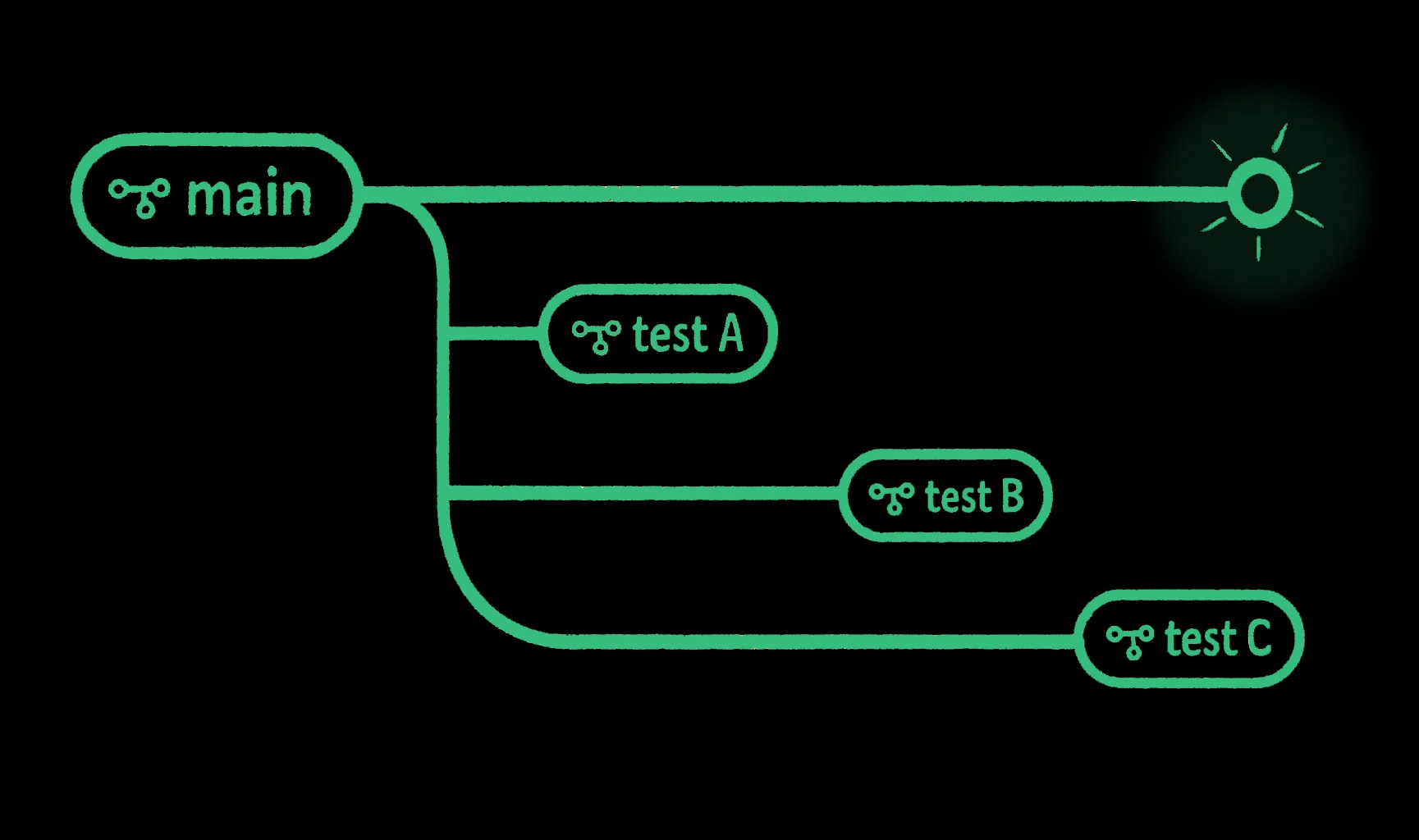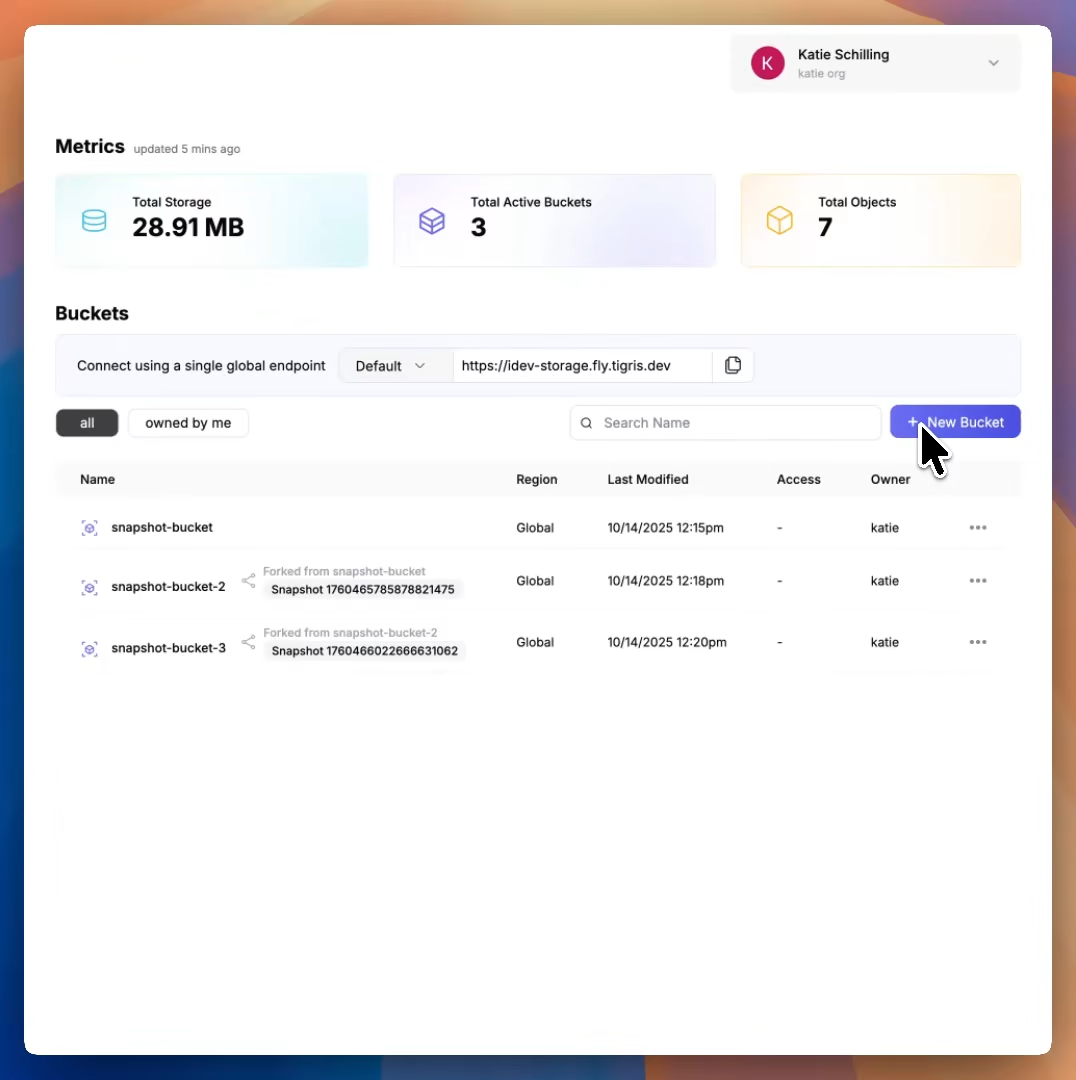Fork Buckets Like You Fork Code

Fork Buckets Like You Fork Code
Fork your data like you fork your code.
With Tigris, you can instantly create an isolated copy of your data for development, testing, or experimentation. Have a massive production dataset you want to play with? You don't need to wait for a full copy. Just fork your source bucket, experiment freely, throw it away, and spin up a new one — instantly.
Forked buckets are isolated. Their timelines diverge from the source bucket at the moment of the fork. It's the many-worlds version of object storage.

Time travel for your entire bucket
Traditional object storage treats a bucket as a flat mutable namespace. You can version individual objects, but there's no consistent view of the entire bucket at a point in time.
And if you want to experiment, by spinning up an isolated copy of your dataset, you're forced to copy every object into a new bucket: a storm of I/O, duplicated data, and waiting around for terabytes to move.
Imagine if your code repo didn't have git clone or git branch, or if you
couldn't fall back to a prior version of your AI generated code during
development. That's where object storage has been stuck– until now.
In Tigris, every object is immutable. Each write creates a new version, timestamped and preserved. That immutability allows us to version the entire bucket, and capture it as a single snapshot. Each object maintains its own version chain, and a snapshot is an atomic cut across all those chains at a specific moment in time.
How bucket forks work
Forks are built on top of snapshots. A snapshot freezes your entire bucket at a point in time. A fork creates a new bucket from that snapshot, sharing data without copying it.
Under the hood, Tigris uses a distributed key-value store (FoundationDB) to store object metadata ordered by time. Each write appends a new immutable record to a globally ordered log (using negative epoch timestamps for efficient lookup). Instead of scanning the KV store for an object key name, we scan by timestamp. Each write appends a new immutable record into a globally ordered log.
So when you create a fork, Tigris simply references the correct object versions from the snapshot, no data movement required.
Retrieving a snapshot to make a fork is:
Scanning by timestamp,
for each object,
return the newest version ≤ snapshot timestamp
write new metadata pointing to the fork bucket name
It's fast, and it's cheap. Make as many as you want.
Why forks matter
Restoring from snapshots fits the classic storage model: "Oops, something broke! Roll back to the snapshot." Forking, though, unlocks a whole new set of workflows.
Isolated development environments
Safely test transformations, migrations, or experiments without touching production. Every developer or job can have their own fork, an isolated copy of the data that behaves like the real thing.
Built in dataset versioning and reproducibility
Data version control is an entire class of product. Instead of bolting on (and paying for) a catalog or a proxy, version control is built directly into object storage. Keep a frozen, isolated dataset copy linked to the model version and training metadata.
A/B testing and multi-model experiments
If two models train or evaluate on slightly different datasets, comparisons fall apart. Forks let you lock each data split (train/validation/test) to an immutable copy for perfect reproducibility.
Many agent workflows
Agents are nondeterministic, and often chaotic. Forks make it easy to sandbox them. Seed a bucket with everything your agent needs to operate (code, unstructured data, configs), and fork it per agent. Each agent gets its own world: no collisions, no corruption, full reproducibility.
Example: For each agent, its own fork
Tens or even thousands of agents can safely work in parallel, each with their own copy of the data. Let's walk through the pattern using Tigris:
- Python
- JavaScript
from tigris_boto3_ext import (
create_fork,
create_snapshot_bucket,
create_snapshot,
get_snapshot_version,
)
# Create a seed bucket
seed_bucket_name = 'agent-seed'
create_snapshot_bucket(s3, seed_bucket_name)
# Create snapshot
result = create_snapshot(s3_client, seed_bucket_name, snapshot_name='agent-seed-v1')
snapshot_version = get_snapshot_version(result)
# Fork the bucket from the snapshot for a new agent
agent_bucket_name = f"{seed_bucket_name}-agent-{agent_id}";
create_fork(s3_client, agent_bucket_name, seed_bucket_name, snapshot_version=snapshot_version)
# Start the agent using the forked bucket
start_agent(agent_bucket_name)
import { createBucket, createBucketSnapshot } from "@tigrisdata/storage";
// Create a seed bucket
const seedBucketName = "agent-seed";
await createBucket(seedBucketName, {
enableSnapshot: true,
});
// Create snapshot
const snapshot = await createBucketSnapshot(seedBucketName, {
name: "agent-seed-v1",
});
const snapshotVersion = snapshot.data?.snapshotVersion;
// Fork the bucket from the snapshot for a new agent
const agentBucketName = `${seedBucketName}-agent-${Date.now()}`;
const forkResult = await createBucket(agentBucketName, {
sourceBucketName: seedBucketName,
sourceBucketSnapshot: snapshotVersion,
});
if (forkResult.data) {
// Start the agent using the forked bucket
await startAgent(agentBucketName);
}
This pattern gives every agent its own isolated fork. You can scale this up — a fork per swarm, per run, or even per task.
What gets easier with bucket forks
When each agent (or developer, or experiment) has its own fork:
- No collisions: Writes are isolated; rogue processes can't clobber shared data.
- Instant rollback: Delete a fork and start again from the snapshot.
- Perfect consistency: Data is frozen at creation time, no re-listing, no locking, no reconciliation.
- Cleaner debugging: Restore a snapshot, rerun the code, and get identical results.
Conclusion: Share data safely with forks
Bucket forking turns your object storage into a controlled lab.
Every experiment is isolated. Every result is reproducible. Every rollback is instant.
And since forks are built on top of snapshots, you get all the snapshotting power too: full time travel for your data.
Whether you're training AI models, running analytics pipelines, or building with hundreds of agents, bucket forking helps you move fast without breaking production.
Ready to fork your data like code?
Get instant, isolated copies of your data for development, testing, or experimentation.